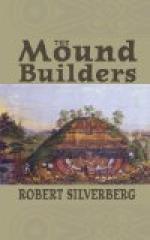Antiquity of the mound-builders.—Upon this point there are many theories, some regarding them as the earliest of the Indian tribes. Others give them a very great age and claim them to belong to preadamite man. By far the greater number of archaeologists, however, place their existence at about 2,000 years ago.
In favor of the latter view we may call as evidence the present forest trees, which, though of great age, still flourish on some of the ancient remains. On one of the mounds at Marietta, Ohio, there stood a gigantic tree, which, when cut down, displayed 800 rings of annual growth. In many other places, trees of the age of 750 years have been cut, and underneath them evidences of previous forests found. One tree 750 years old was found to have underneath it, on the walls of one of the forts in Ohio, the cast of another tree of equal size, which would carry us back at least 1,500 years since those trees began to grow on those deserted walls of that ancient fortification.
We have some data in the vegetable accumulations in the ancient mining shafts near Lake Superior, as well as in the vegetable and other matter deposited in the numerous pits and trenches found among the works. Though these evidences cannot give the exact time of their accumulation, yet they give it approximately, by comparison with similar recent deposits.
There is another still stronger argument in favor of their antiquity, viz., the decayed condition of the skeletons. The skeletons of the oldest Indian tribes are comparatively sound while those of the Mound-builders are much decayed. If they are sound when brought out, they at once begin to disintegrate in the atmosphere, which is a sure sign of their antiquity. We know that some skeletons in Europe have lately been exhumed, which, though buried more than 1,000 years, are comparatively firm and well-preserved. We are, I think, bound to ascribe a greater antiquity to the Mound-builders’ skeletons than to those found in the ancient barrows of Europe. Other considerations, such as stream encroachment, and river-terrace formation, might also be brought in as presumptive arguments in favor of their great antiquity.
Origin of the mound-builders.—This is a question not easily answered. It brings me into no discredit before the educated world to acknowledge ignorance on this mysterious point. The study of Craniology and Philology, in connection with Ethnology, shall alone throw light on this subject. Dr. Wilson says, in his “Prehistoric Man” (p. 123), “The ethnical classification of this strange race is still an unsettled question,” and he declares without fear of contradiction, “that especially concerning the Scioto Mound skull, the elevation and breadth of the frontal bone, differs essentially from the Indian, and that the cerebral development was more in accordance with the character of that singular people, who without architecture have perpetuated, in mere structures of earth, the evidences of geometric skill, a definite means of determining angles, a fixed standard of measurement, and the capacity as well as the practice of repeating geometrically constructed works of large and uniform dimensions.”




